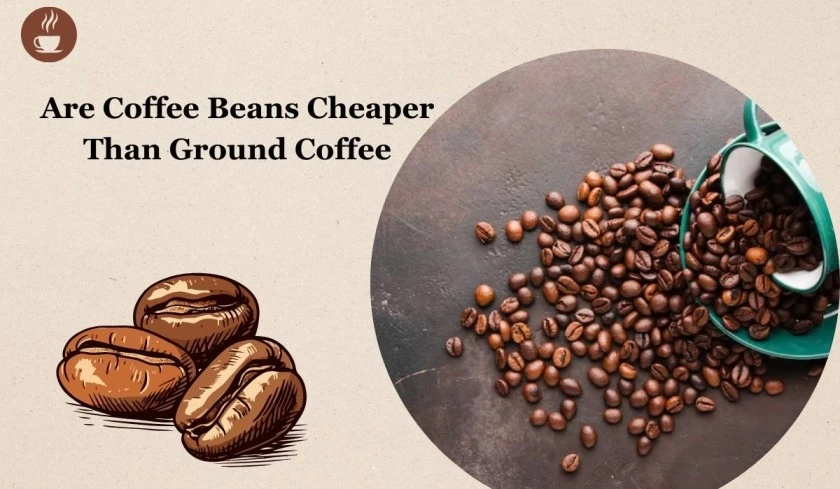
We know that making espresso at home is possible, but not unchangingly worth it. With the typical machine stuff so expensive and complicated to operate, why bother?
But then again, we’ve all had those mornings where you’re worn-out and just need a good cup of coffee surpassing tackling your day.
Wouldn’t it be nice if there was an easier way? Well luckily for us coffee addicts with limited space (or cash), there are options!
In this article, I will show you a few ways you can make espresso without any fancy equipment or expensive machines.
What Is Espresso Coffee?
If you didn’t know already, espresso is a well-matured coffee drink. It’s typically prepared by forcing pressurized water through finely-ground coffee beans. Espresso coffee has very unshared savor notes and it’s strong unbearable for plane the strongest of coffee drinkers!
Espresso Beans
Espresso beans play a big role in the overall quality of a cup of espresso. The higher the quality, the largest your end product will be!
Just alimony in mind that you get what you pay for, and cheaper beans might taste stormy or sour. A good rule of thumb is to spend a few uneaten bucks for upper quality fresh beans.
As for the origin of your beans, Arabica beans are the most worldwide (and popular) nomination but if you’re looking for a increasingly unshared taste profile, try out Robusta.
Grinding Coffee Beans
The most important thing well-nigh making espresso is grinding the beans to a specific size. This is what will determine the savor profile of your espresso.
There are a few variegated types of grinders that you can buy but rest assured, most are relatively inexpensive. There are transmission and electric options for sale out there so you should be worldly-wise to find something suitable for what you need.
As we said whilom for espresso you want to make sure that the beans are grounded to a fine consistency. If they are too coarse, you will end up with coffee grounds floating in your coffee which is definitely not pleasant.
The Water
Like all coffee-related drinks, water is a key factor in how well the espresso will turn out. Using tap water is not recommended so if you’re looking to recreate that Italian coffee wits at home, get yourself some good quality filtered water.
What Are The Most Important Ingredients Needed For Making A Tasty Cup of Espresso?
When it comes to making espresso, there are a few key ingredients you’ll need to make a succulent cup of espresso. These include:
⦁ Freshly ground coffee beans: It is one of the most important things you’ll need for making espresso. The fresher the beans, the largest the flavor. If possible, try to use roasted beans within the past week.
⦁ Filtered water: It’s essential to use filtered water when making espresso. This will help to ensure that your coffee tastes unconfined and isn’t unauthentic by any impurities in the water.
⦁ Sugar: While sugar is optional, many people like to add a bit of sweetness to their espresso. If you’re going to add sugar, make sure to use refined grain sugar so that it dissolves easily.
⦁ A filter: You’ll need a filter to strain your espresso and remove any grounds that may have made their way into the final product.
3 Variegated Ways To Make Espresso Without A Machine
There are three main ways you can make espresso without a machine at home. We will go over each of these methods and hopefully, you’ll be worldly-wise to find one that works for you!
1. Moka Pot Espresso

The Moka pot is an interesting transmission coffee maker that was originally created by Alfonso Bialetti in 1933. This method of making espresso is unquestionably pretty popular in Italy.
A Moka Pot has three main parts – the marrow part is the one that holds the water, the middle part contains a filter basket where the ground coffee is placed, and the top part is where the espresso comes out.
When you fill the marrow part with water, it then heats up and rises to the filter basket where that water is forced through the ground coffee and into the top chamber. It then comes out of the spout into your cup!
Let’s have a squint at the step-by-step process for making Moka Pot Espresso:
1. Grind Your Beans
First of all, you need to grind your espresso beans. You should use a medium grind size for this brewing technique.
2. Fill The Marrow Part Of The Pot With Water
Next, fill the marrow part of the Moka pot with filter water. If you take a tropical squint at the marrow part of your maker you will see a small mark from the manufacturer. This is the mark for the value of water you should use.
Keep in mind that the increasingly water you add, it will take longer for your espresso to come out. Using too little water on the other hand could prevent the coffee from flowing out properly.
3. Place The Ground Coffee In The Filter Basket
Now that the water is in place, you can add your ground espresso to the filter basket. Fill it up just unbearable so that it creates a level surface.
4. Place The Filter Basket Into The Moka Pot
You are now ready to put the filter basket with the ground coffee into the marrow part of the Moka Pot. Place it gently and seal it thoughtfully so that the water doesn’t leak out.
5. Put The Top Part Of The Pot Into Place
Finally, you have to place the top part of your Moka pot into place, making sure that it fits tightly onto the rest of the pot.
6. Heat The Pot
Now you are ready to turn the stove up to medium-high heat and place the pot on the stovetop. You can moreover use an electric burner if you want.
7. Wait For The Espresso To Come Out
You’ll know that your espresso is ready when you hear a hissing sound coming from the spout and see some steam rising from it. This usually takes well-nigh three to five minutes so patience is key!
8. Pour Your Espresso Into A Cup
Et voila! You should now have some succulent espresso in your cup that you made without a fancy espresso machine!
2. Make Espresso Using An AeroPress

The AeroPress is a quick and easy way to make espresso at home! It’s quite affordable too but be warned it is so easy to use that you could end up spending lots of time making coffee for yourself!
The AeroPress is made by AeroPress Inc. (formerly known as Aerobie) and was created by Alan Adler in 2005. The diamond is super simple. It has a cylindrical chamber that holds water and your ground coffee.
There is moreover a plunger, which when you push it lanugo forces the espresso through a paper or metal filter at the end of the chamber to your final cup. This then results in a smooth, succulent shot of espresso!
In order to use this transmission coffee maker all you need to do is follow these steps:
1. Put Your Ground Coffee In The AeroPress Chamber
You will want to use a fine espresso visionless roast for the weightier results, but finger self-ruling to experiment with your favorite blends!
2. Add Hot Water And Stir The Coffee
Add hot water into the chamber, and requite it a stir. Then let it sit for well-nigh a minute so that you can let any sediment in the grinds sink to the marrow of the chamber surpassing moving on.
3. Push Lanugo On The Plunger
Now you are ready to push lanugo on the plunger to create your espresso shot. The pressure in the chamber will gravity your coffee to travel through the small metal or paper filter at the end of it. This process shouldn’t take you increasingly than a few seconds.
4. Pour Your Espresso Into A Mug And You Are Done!
Get ready, here comes your succulent espresso! If you want, you can add a shot of milk to make it taste plane better.
Note: The recommended water temperature for this method is between 195 and 205 degrees Fahrenheit.
3. Make Espresso With The French Press

The French printing is flipside simple and affordable way to make espresso at home. It’s an easy process and one that you can do in just a few minutes!
The French Printing is made out of glass or stainless steel and features a cylindrical carafe with a metal filter tying to a plunger.
It dates when to the early 1850s when it was used to mash coffee. The first patent for this device is from 1930, although at that time it was tabbed a coffee press, not a French Press.
Today you can buy these transmission coffee makers in a metal or glass carafe at a very low price!
Let’s now squint at the steps involved in making espresso with this coffee maker:
1. Make Sure Your Water Is At The Right Temperature
Make sure your water is at the right temperature surpassing using it for this method. The platonic temperature range for this device is between 195 and 205 degrees Fahrenheit.
2. Grind Your Coffee Beans And Place Them In The Carafe
Next, grind your coffee beans up into a medium-coarse grind and place them in the carafe.
3. Add Hot Water And Wait For The Coffee To Brew
Now just add your hot water into the coffee, stir it well, and let it sit for a couple of minutes so that all the sediment from the grinds can settle to the marrow surpassing proceeding to the next step.
4. Printing The Plunger
After the waiting period, printing lanugo on the plunger until you have extracted your espresso. You may need to do this multiple times if you want to make sure you’ve gotten all of the espressos out of your freshly spirituous coffee.
5. Serve Your Succulent Espresso With Milk Or Cream
Once you have your espresso, finger self-ruling to add some milk or surf in order to enhance the savor plane further!
Frequently Asked Questions
How Much Coffee Should I Use?
This will depend on your method of making espresso without a machine. Generally speaking, you’ll want to use about two tablespoons of coffee per cup of espresso. However, finger self-ruling to retread this to taste.
How Fine Should I Grind My Coffee?
Again, this will depend on the method you’re using. You’ll want to use a medium-coarse grind for the stovetop espresso maker and French printing methods. For the Aeropress method, you’ll want to use a fine grind.
How do I Know When my Espresso is Ready?
For the stovetop espresso maker and French printing methods, your espresso will be ready without four minutes. For the Aeropress method, it will be ready without 30 seconds.
How Can I Retread The Strength of My Espresso?
The strength of your espresso will depend on the method you’re using, as well as the value of coffee and water you use. For a weaker espresso, use less coffee or mash for less time. For a increasingly robust espresso, do the opposite.
Can I Make Espresso Without A Machine Using Pre-Ground Coffee?
Yes, you can. However, the quality of your espresso will be lower since pre-ground coffee is not as fresh. For the weightier results, grind your own coffee beans.
Final Thoughts
So yes, you can make espresso without a machine. Whether it’s a Moka pot or an AeroPress or French press, there are many variegated ways to produce that rich and flavorful coffee wits we love so much!
If this post has helped introduce you to something new well-nigh making your favorite beverage, share it with friends who might enjoy learning how they too can have their own little “cafe” at home–without any fancy equipment needed.
Which method of brewing do you think is the weightier for producing espresso? Let us know in the comments below!














